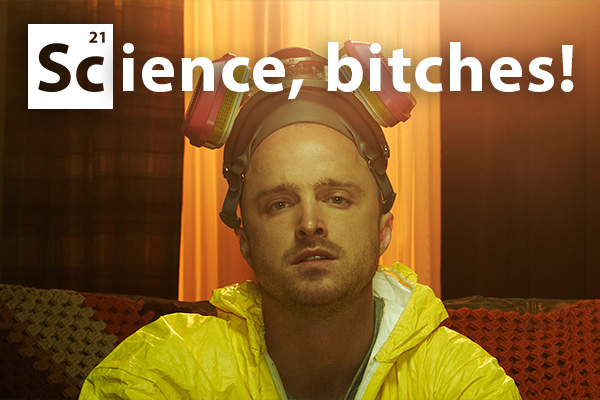Science, Bitches | Issue 25
Body problems
In Breaking Bad, chemistry teacher Walter White turns to making crystal meth to support his family because the US health system sucks. However, in this line of work, disputes are typically resolved through violence. So, as the show progresses, Walter and his partner Jesse Pinkman (pictured above) occasionally find themselves having to dispose of the, uh, evidence.
It is an interesting problem, the disposal of human corpses. There is a range of clandestine options, from a hole in the ground to a pig farm, but dissolving a body definitely has its advantages.
For the job, Walter brings back hydrofluoric acid from the high school chemical store (a little unlikely, but we’ll roll with it). This is a solution of hydrogen fluoride, and while it’s not technically a “strong” acid, it’s still highly corrosive – it can dissolve rocks, metal and glass! I just wonder if Walt might have chosen something else if he had looked further into mortuary science.
The main reason hydrofluoric acid is a bad choice is because of how toxic it is. The ideal outcome here is to destroy the body, not yourself – you’d have to take some serious safety precautions. Any contact with the stuff allows for penetration of the fluoride ion, which can bind the biologically important ion, calcium. It can cause really nasty delayed burns, nerve and bone damage, cardiac arrest and death. Hydrofluoric acid would actually make better use as a poison; don’t use it to dispose of evidence even if it could eventually eat through a body.
There is more of a history to using sulphuric acid (H2SO4). This is what the truly despicable John George Haigh used to dispose of his victims, after selling their valuables. Unfortunately for Haigh, his final victim’s dentures were recovered and identified by her dental surgeon. According to the case write up in 1950, if these acrylic resin dentures had been immersed the acid for four weeks instead of three days, even they would have completely disappeared. If only Haigh had more patience!
But serial killers aren’t the only people interested in body disposal; funeral directors can now offer an eco-friendly alternative to traditional cremation: alkaline hydrolysis, or “green cremation.” It’s a relatively new method, where the body is dissolved in a solution of lye (sodium hydroxide) at high temperatures (typically over 100 °C). In a few hours the soft tissues are liquefied to amino acids, sugars, and salts and the remaining bones are soft and easily crushed. Sodium hydroxide is typically used in drain cleaners and can be disposed of, along with the body remains, through the sewer system. Lovely. If so desired, the bone dust can be given to relatives in an urn. Some groups aren’t so keen on flushing their loved ones down the drain, but I bet Jesse Pinkman would share my enthusiasm for another practical application of scientific knowledge. That’s science, bitches!



